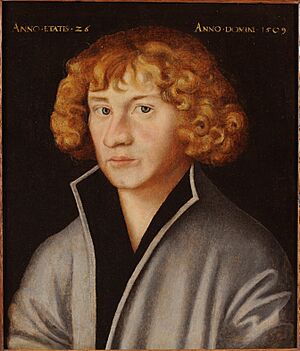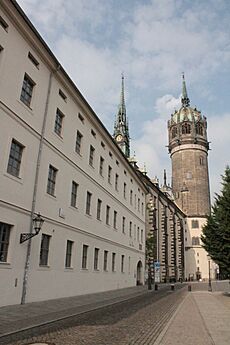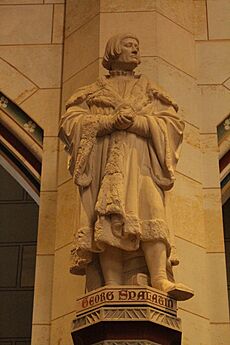George Spalatin facts for kids

Georg Spalatin was a very important German scholar and religious leader. His real name was Georg Burkhardt. He lived from 1484 to 1545. He chose the name "Spalatin" as a pseudonym, which is like a pen name.
Spalatin was a humanist, meaning he studied classical subjects like history and literature. He was also a theologian, someone who studies religion. He played a big part in the Protestant Reformation, a major religious movement in Europe. He worked as a secretary for Frederick the Wise, who was a powerful ruler called an Elector in Saxony.
Contents
Early Life and Education
Georg Burkhardt was born in a town called Spalt, near Nuremberg, in 1484. His father worked as a tanner, preparing animal hides. When he was thirteen, Georg went to Nuremberg to study.
Soon after, he attended the University of Erfurt. He earned his first degree there in 1499. At Erfurt, a very important professor named Nikolaus Marschalk noticed him. Marschalk hired Spalatin as his assistant. In 1502, Spalatin moved with Marschalk to the new University of Wittenberg. He lived near the Schlosskirche, Wittenberg (Castle Church) there.
In 1505, Spalatin went back to Erfurt to study jurisprudence, which is the study of law. He met Conrad Mutianus, a leading German humanist. Mutianus and his friends welcomed Spalatin.
Becoming a Priest and Tutor
A friend helped Spalatin get a job teaching new students at a monastery in Georgenthal. In 1508, he became a priest. The same bishop who made Martin Luther a priest also ordained Spalatin.
In 1509, Mutianus suggested Spalatin to Frederick the Wise. Frederick was a very powerful ruler in Saxony. In 1511, Frederick sent Spalatin back to Wittenberg. His job was to teach Frederick's nephews, including John Frederick, who would later become an Elector himself.
Working for Frederick the Wise
Spalatin quickly earned Frederick's trust. He was given a special position at a church in Altenburg. In 1512, Frederick made him his librarian. Spalatin also became the court chaplain (a religious advisor) and secretary. He handled all of Frederick's important letters and documents.
Spalatin was very knowledgeable, especially in Greek. This made him very valuable to the Saxon court.
Spalatin and Martin Luther
Even though Spalatin was a priest, he was more interested in humanism than in theology (religious studies). We don't know exactly how he met Martin Luther, but it was likely in Wittenberg. Luther became Spalatin's main advisor on religious matters.
Spalatin's letters to Luther are lost, but Luther's replies still exist. Spalatin often read Luther's writings to Frederick the Wise. He also translated Luther's Latin writings into German for the Elector.
Role in the Reformation
Spalatin went with Frederick to important meetings, like the Diet of Augsburg in 1518. A "Diet" was a formal meeting of the Holy Roman Empire. He was involved in talks with representatives of the Pope. He was also with Frederick when Charles V became emperor.
Spalatin was present at the Diet of Worms, another very important meeting. This was during the early, difficult years of the Reformation. Spalatin often tried to convince Luther not to publish books or act too strongly against the Pope. However, if Luther did, Spalatin was ready to translate his books or explain his actions.
Later Life and Legacy
When Frederick the Wise died in 1525, Spalatin left the Saxon court. However, he continued to attend the imperial diets. He became an advisor to Frederick's successors, John and John Frederick.
Spalatin moved to Altenburg and lived as a canon (a type of priest). He tried to bring reforms to the church there, but it was not very successful. He also got married in the same year.
From 1526 until his death, Spalatin mostly worked on visiting churches and schools in Saxony. He reported on how church money was being used. He also helped with this work in another part of Saxony. He was a regular visitor to Wittenberg University.
Before he died, Spalatin became very sad. He passed away in Altenburg in 1545. He was buried in the vault of the St. Bartholomew church.
Works
Spalatin wrote several important works. Some were published, and some were not. Here are a few of them:
- Annales Reformationis oder Jahrbücher von der Reformation Lutheri (Yearbooks of Luther's Reformation), published in 1718.
- "Das Leben and die Zeitgeschichte Friedrichs des Weisen" (The Life and History of Frederick the Wise's Time), published in 1851.
- The Spalatin Chronik, or The Chronicle of Saxony and Thurinigia. This book was made around 1510 for Frederick the Wise. It has more than 1000 small paintings from the workshop of Lucas Cranach.



